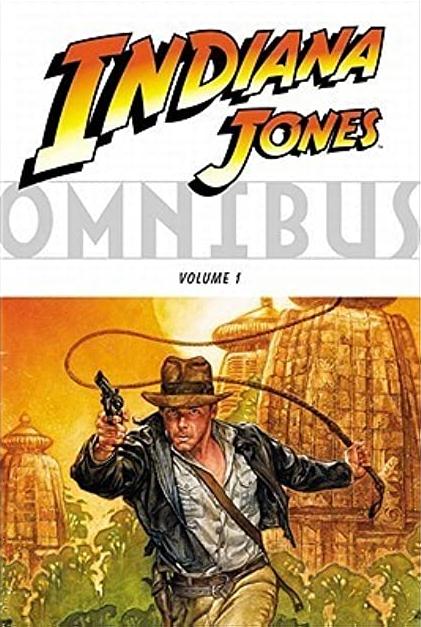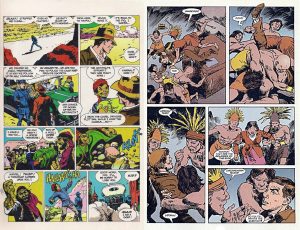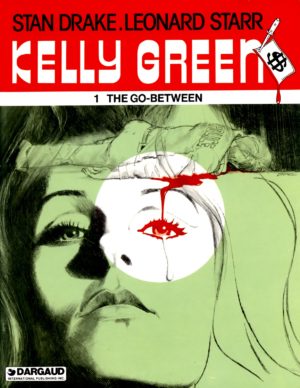Review by Frank Plowright
In hindsight it seems unusual that Dark Horse would issue Indiana Jones comics, yet not compile them into graphic novels, but so it was in the 1990s. For fans, then, this 2008 Omnibus is very welcome for supplying ‘Thunder in the Orient’ and ‘Arms of Gold’ for the first time in book form.
Before them, though, there’s ‘The Fate of Atlantis’, a story that was compiled as a graphic novel. It’s based on a computer game written by Hal Barwood and Noah Falstein, adapted by William Messner-Loebs with Dan Barry on art, then taking over the writing also. Perhaps the constant changes of location might betray the game origins, but otherwise it’s a thrill ride from start to finish. In a pre-internet era plenty of visual research was required to follow Indy’s globetrotting, and Barry’s beautifully rendered environments are accompanied by meticulous period detail, which applies whether it’s a 1930s American city or an ancient Mayan temple. Indy is accompanied by a glamorous mystical archaeologist, Nazis present a constant threat, and there’s even a scene of Indy using a whip to good effect. A crowd-pleaser, then.
Barry’s sample art shows a joyous moment opening ‘Thunder in the Orient’ showcasing his skills. The storytelling is clear and precise, the characterisation emotive and the period cars exactly recreated. He returns psychic archaeologist Sophie Hapgood, introduces the sympathetic young Khamal and sets his story of new scrolls of Buddha’s writings against the backdrop of Japanese expansion and acquisition in the 1930s. Likenesses of Harrison Ford weren’t permitted, but Barry creates a creditable stand-in and he has a real cinematic sweep when it comes to the dangers. An early ambush sequence in Afghanistan is spectacular, and Barry matches it several times having devised his settings well and dropped in the foreshadowing. There’s also a hint of Terry and the Pirates in what’s an even more enjoyable romp than the first story making good use of complex political differences in wild lands. The only shame is that Dan Spiegle draws the finale. Although a very good artist, he’s less naturalistic and this clashes with the earlier pages.
Lee Marrs opens ‘Arms of Gold’ with a more fractious side of Indy, angry at his college course being allocated to a visiting professor, but that’s the prelude to a South American trip. It’s a different type of adventure, one that’s still based on an archaeological hunt, but without the massive action set pieces of Barry’s vision, the destination not reached until halfway. Until then the action is more the type of a home-based detective. Leo Durañona keeps it closed in, and while there’s no lack of detail to his art, it doesn’t have the epic quality Barry applied.
There’s a secret to be revealed in ‘Arms of Gold’, although a fair percentage of readers might suspect the revelation, and once that’s out of the way the story improves, but a problem throughout is how dependent things are on Indy’s memory. It fluctuates according to requirements and while good fortune is key to Indy’s adventures, it’s a little too good here.
As of writing, copies of this collection are hard to come by and expensive, but ‘Thunder in the Orient’ is a great adventure, making the price worth considering.





